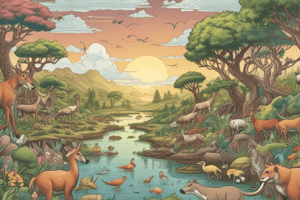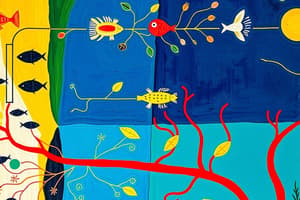Podcast
Questions and Answers
What is the primary reason why there are fewer organisms at higher trophic levels?
What is the primary reason why there are fewer organisms at higher trophic levels?
- The energy transfer between trophic levels is only 10% efficient. (correct)
- Organisms at higher trophic levels reproduce more slowly.
- Organisms at higher trophic levels require more food.
- Organisms at higher trophic levels are more likely to be preyed upon.
Which trophic level stores the most energy?
Which trophic level stores the most energy?
- Tertiary consumers
- Primary producers (correct)
- Secondary consumers
- Primary consumers
Why are decomposers typically not shown in food webs?
Why are decomposers typically not shown in food webs?
- Decomposers are too small to be represented.
- Decomposers consume organisms from all trophic levels, so their arrows would point everywhere. (correct)
- Decomposers are not important to the ecosystem.
- Decomposers are not considered a part of the food chain.
What is the difference between a food chain and a food web?
What is the difference between a food chain and a food web?
What would likely happen if all the wolves were removed from an ecosystem?
What would likely happen if all the wolves were removed from an ecosystem?
How do invasive species affect food webs?
How do invasive species affect food webs?
What is the difference between a primary consumer and a secondary consumer?
What is the difference between a primary consumer and a secondary consumer?
Which of these is NOT a characteristic of a food web?
Which of these is NOT a characteristic of a food web?
Which of the following organisms are considered consumers?
Which of the following organisms are considered consumers?
What role do producers play in an ecosystem?
What role do producers play in an ecosystem?
What type of organism is a panda classified as?
What type of organism is a panda classified as?
Which of the following statements accurately describes decomposers?
Which of the following statements accurately describes decomposers?
In a food chain, what do the arrows represent?
In a food chain, what do the arrows represent?
Which example represents a scavenger?
Which example represents a scavenger?
What is the primary function of herbivores in a food chain?
What is the primary function of herbivores in a food chain?
Removing a primary consumer from a food web would likely result in what?
Removing a primary consumer from a food web would likely result in what?
Flashcards
Producers
Producers
Organisms that make their own food through photosynthesis, using sunlight to convert carbon dioxide and water into glucose and oxygen.
Consumers
Consumers
Organisms that consume other organisms for energy. They cannot produce their own food.
Herbivore
Herbivore
Organisms that only eat plants or other producers.
Carnivore
Carnivore
Signup and view all the flashcards
Omnivore
Omnivore
Signup and view all the flashcards
Decomposers
Decomposers
Signup and view all the flashcards
Food Chain
Food Chain
Signup and view all the flashcards
Food Web
Food Web
Signup and view all the flashcards
Trophic Level
Trophic Level
Signup and view all the flashcards
Primary Producers
Primary Producers
Signup and view all the flashcards
Primary Consumers
Primary Consumers
Signup and view all the flashcards
Secondary Consumers
Secondary Consumers
Signup and view all the flashcards
Tertiary Consumers
Tertiary Consumers
Signup and view all the flashcards
The 10% Rule
The 10% Rule
Signup and view all the flashcards
Study Notes
Food Chains and Food Webs
- Food chains and food webs illustrate feeding relationships in ecosystems
- Food chains: show a simple linear path of who eats whom
- Food webs: show more complex and interconnected feeding relationships (multiple food chains)
Learning Goals
- Build food webs and food chains
- Identify the trophic level of an organism (its position in a food chain)
- Determine how removing or adding an organism affects the food web
Consumers
- Consumers obtain energy by consuming other organisms
- Examples: white-tailed deer, spiny softshell turtle, green heron
Producers
- Producers create their own food through photosynthesis
- Examples: sugar maple tree, moss, ostrich fern
Decomposers/Detritivores
- Decomposers/Detritivores break down organic matter (dead organisms/waste)
- Examples: chicken of the woods fungi, lichen, worms, insects, bacteria
Photosynthesis
- CO2 + H2O → C6H12O6 + O2
- Producers use sunlight to convert carbon dioxide and water into glucose (food) and oxygen
Consumers/Heterotrophs
- Organisms that obtain energy from other organisms
- Herbivores: only eat plants/producers
- Examples: panda, giraffe, rabbit
- Carnivores: only eat animals
- Examples: lion, lynx
- Omnivores: eat both plants and animals
- Examples: humans, dogs
- Scavengers: eat remains of dead organisms
- Examples: vultures
Trophic Levels
- Trophic levels describe feeding positions in a food chain
- Organisms are classified according to their feeding level compared to the producers
- Trophic level changes depending on food sources/predators
Arrows in Food Chains/Webs
- Arrows in food chains and webs point towards the organism that eats
- Arrows represent energy flow
The 10% Rule
- Each trophic level only transfers 10% of energy to the next level
- Limits the number of trophic levels an ecosystem can support
- More organisms at lower trophic levels because of energy transfer limits
Role of Decomposers
- Decomposers/Detritivores are crucial for breaking down organic material
- Food webs typically don't explicitly include decomposers but are essential for nutrient cycling
Food Webs
- Food chains are simplified models, not found in nature
- Food webs show interconnected food chains in an ecosystem exhibiting more accurate feeding relationships
- Food webs are useful for studying the impacts of removing or adding species
What is a Food Web?
- A food web represents all the interconnected food chains in an ecosystem
- It reveals the feeding relationships between all living organisms
- Useful tools for studying impacts of changes in an ecosystem (removal/addition of species)
Studying That Suits You
Use AI to generate personalized quizzes and flashcards to suit your learning preferences.




